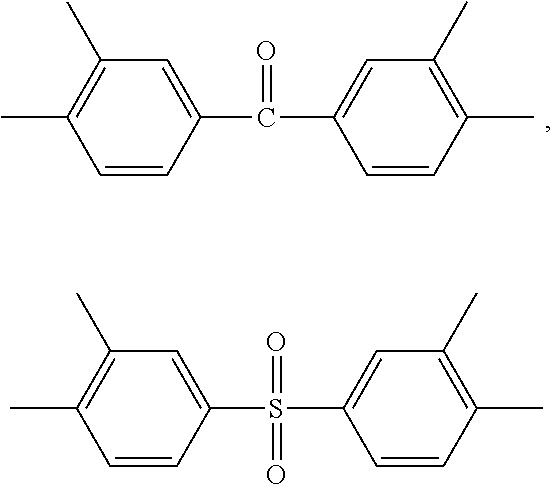Process of separating gases using polyimide membranes
- Summary
- Abstract
- Description
- Claims
- Application Information
AI Technical Summary
Benefits of technology
Problems solved by technology
Method used
Image
Examples
example 1
Preparation of Polyimide Dense Film Membrane Using poly(3,3′,4,4′-diphenylsulfone tetracarboxylic dianhydride-2,4,6-trimethyl-m-phenylenediamine) Polyimide(NPI-1)
[0043]An aromatic poly(3,3′,4,4′-diphenylsulfone tetracarboxylic dianhydride-2,4,6-trimethyl-m-phenylenediamine) polyimide (abbreviated as NPI-1) containing UV cross-linkable sulfonic groups was synthesized from 3,3′,4,4′-diphenylsulfone tetracarboxylic dianhydride (DSDA) and 2,4,6-trimethyl-m-phenylenediamine (TMPDA) in DMAc polar solvent by a two-step process involving the formation of the poly(amic acid) followed by a solution imidization process. Acetic anhydride was used as the dehydrating agent and pyridine was used as the imidization catalyst for the solution imidization reaction. For example, a 250 mL three-neck round-bottom flask equipped with a nitrogen inlet and a mechanical stirrer was charged with 10.5 g of TMPDA and 42 g of DMAc. Once TMPDA was fully dissolved, 25.8 g of DSDA solid powder was added to the solu...
example 2
[0045]Evaluation of the CO2 / CH4 and H2 / CH4 separation performance of NPI-1 membrane prepared in Example 1
[0046]The NPI-1 membrane in dense film form was tested for CO2 / CH4 and H2 / CH4 separations at 50° C. under 791 kPa (100 psig) pure gas feed pressure. The results show that the new NPI-1 membrane has intrinsic CO2 permeability of 73.4 Barrers (1 Barrer=10−10 cm3 (STP) cm / cm2 s (cm Hg)) and single-gas CO2 / CH4 selectivity of 25.3 at 50° C. under 791 kPa for CO2 / CH4 separation. This membrane also has intrinsic H2 permeability of 136.6 Barrers and single-gas H2 / CH4 selectivity of 47.1 at 50° C. under 791 kPa for H2 / CH4 separation.
example 3
Preparation of NPI-1 Polyimide Hollow Fiber Membrane Using NPI-1 Polyimide Prepared in Example 1
[0047]A hollow fiber spinning dope containing 29.7 g of NPI-1 polyimide from Example 1, 62.86 g of NMP, 8.48 g of 1,3-dioxolane, 2.51 g of isopropanol, and 2.51 g of acetone was prepared. The spinning dope was extruded at a flow rate of 2.6 mL / min through a spinneret at 50° C. spinning temperature. A bore fluid containing 10% by weight of water in NMP was injected to the bore of the fiber at a flow rate of 0.8 mL / min simultaneously with the extruding of the spinning dope. The nascent fiber traveled through an air gap length of 5 cm at room temperature with a humidity of 25%, and then was immersed into a water coagulant bath at 21° C. and wound up at a rate of 8.0 m / min. The water-wet fiber was annealed in a hot water bath at 85° C. for 30 minutes. The annealed water-wet fiber was then sequentially exchanged with methanol and hexane for three times and for 30 minutes each time, followed by...
PUM
| Property | Measurement | Unit |
|---|---|---|
| Temperature | aaaaa | aaaaa |
| Volume | aaaaa | aaaaa |
| Length | aaaaa | aaaaa |
Abstract
Description
Claims
Application Information
 Login to View More
Login to View More - R&D
- Intellectual Property
- Life Sciences
- Materials
- Tech Scout
- Unparalleled Data Quality
- Higher Quality Content
- 60% Fewer Hallucinations
Browse by: Latest US Patents, China's latest patents, Technical Efficacy Thesaurus, Application Domain, Technology Topic, Popular Technical Reports.
© 2025 PatSnap. All rights reserved.Legal|Privacy policy|Modern Slavery Act Transparency Statement|Sitemap|About US| Contact US: help@patsnap.com



